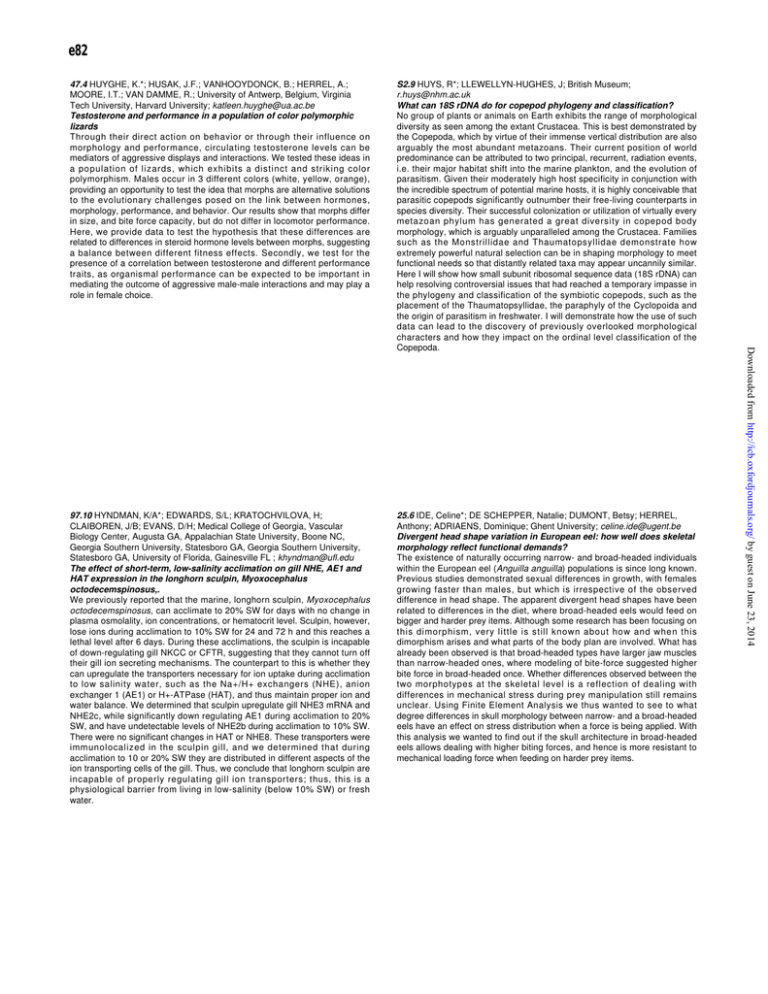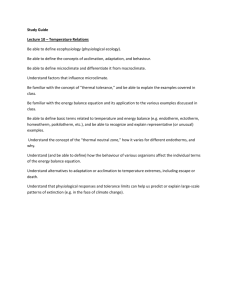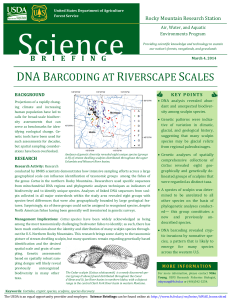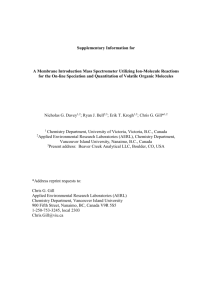47.4 S2.9 What can 18S rDNA do for copepod phylogeny and classification?
advertisement

e82 S2.9 HUYS, R*; LLEWELLYN-HUGHES, J; British Museum; r.huys@nhm.ac.uk What can 18S rDNA do for copepod phylogeny and classification? No group of plants or animals on Earth exhibits the range of morphological diversity as seen among the extant Crustacea. This is best demonstrated by the Copepoda, which by virtue of their immense vertical distribution are also arguably the most abundant metazoans. Their current position of world predominance can be attributed to two principal, recurrent, radiation events, i.e. their major habitat shift into the marine plankton, and the evolution of parasitism. Given their moderately high host specificity in conjunction with the incredible spectrum of potential marine hosts, it is highly conceivable that parasitic copepods significantly outnumber their free-living counterparts in species diversity. Their successful colonization or utilization of virtually every metazoan phylum has generated a great diversity in copepod body morphology, which is arguably unparalleled among the Crustacea. Families such as the Monstrillidae and Thaumatopsyllidae demonstrate how extremely powerful natural selection can be in shaping morphology to meet functional needs so that distantly related taxa may appear uncannily similar. Here I will show how small subunit ribosomal sequence data (18S rDNA) can help resolving controversial issues that had reached a temporary impasse in the phylogeny and classification of the symbiotic copepods, such as the placement of the Thaumatopsyllidae, the paraphyly of the Cyclopoida and the origin of parasitism in freshwater. I will demonstrate how the use of such data can lead to the discovery of previously overlooked morphological characters and how they impact on the ordinal level classification of the Copepoda. 97.10 HYNDMAN, K/A*; EDWARDS, S/L; KRATOCHVILOVA, H; CLAIBOREN, J/B; EVANS, D/H; Medical College of Georgia, Vascular Biology Center, Augusta GA, Appalachian State University, Boone NC, Georgia Southern University, Statesboro GA, Georgia Southern University, Statesboro GA, University of Florida, Gainesville FL ; khyndman@ufl.edu The effect of short-term, low-salinity acclimation on gill NHE, AE1 and HAT expression in the longhorn sculpin, Myoxocephalus octodecemspinosus,. We previously reported that the marine, longhorn sculpin, Myoxocephalus octodecemspinosus, can acclimate to 20% SW for days with no change in plasma osmolality, ion concentrations, or hematocrit level. Sculpin, however, lose ions during acclimation to 10% SW for 24 and 72 h and this reaches a lethal level after 6 days. During these acclimations, the sculpin is incapable of down-regulating gill NKCC or CFTR, suggesting that they cannot turn off their gill ion secreting mechanisms. The counterpart to this is whether they can upregulate the transporters necessary for ion uptake during acclimation to low salinity water, such as the Na+/H+ exchangers (NHE), anion exchanger 1 (AE1) or H+-ATPase (HAT), and thus maintain proper ion and water balance. We determined that sculpin upregulate gill NHE3 mRNA and NHE2c, while significantly down regulating AE1 during acclimation to 20% SW, and have undetectable levels of NHE2b during acclimation to 10% SW. There were no significant changes in HAT or NHE8. These transporters were immunolocalized in the sculpin gill, and we determined that during acclimation to 10 or 20% SW they are distributed in different aspects of the ion transporting cells of the gill. Thus, we conclude that longhorn sculpin are incapable of properly regulating gill ion transporters; thus, this is a physiological barrier from living in low-salinity (below 10% SW) or fresh water. 25.6 IDE, Celine*; DE SCHEPPER, Natalie; DUMONT, Betsy; HERREL, Anthony; ADRIAENS, Dominique; Ghent University; celine.ide@ugent.be Divergent head shape variation in European eel: how well does skeletal morphology reflect functional demands? The existence of naturally occurring narrow- and broad-headed individuals within the European eel (Anguilla anguilla) populations is since long known. Previous studies demonstrated sexual differences in growth, with females growing faster than males, but which is irrespective of the observed difference in head shape. The apparent divergent head shapes have been related to differences in the diet, where broad-headed eels would feed on bigger and harder prey items. Although some research has been focusing on this dimorphism, very little is still known about how and when this dimorphism arises and what parts of the body plan are involved. What has already been observed is that broad-headed types have larger jaw muscles than narrow-headed ones, where modeling of bite-force suggested higher bite force in broad-headed once. Whether differences observed between the two morphotypes at the skeletal level is a reflection of dealing with differences in mechanical stress during prey manipulation still remains unclear. Using Finite Element Analysis we thus wanted to see to what degree differences in skull morphology between narrow- and a broad-headed eels have an effect on stress distribution when a force is being applied. With this analysis we wanted to find out if the skull architecture in broad-headed eels allows dealing with higher biting forces, and hence is more resistant to mechanical loading force when feeding on harder prey items. Downloaded from http://icb.oxfordjournals.org/ by guest on June 23, 2014 47.4 HUYGHE, K.*; HUSAK, J.F.; VANHOOYDONCK, B.; HERREL, A.; MOORE, I.T.; VAN DAMME, R.; University of Antwerp, Belgium, Virginia Tech University, Harvard University; katleen.huyghe@ua.ac.be Testosterone and performance in a population of color polymorphic lizards Through their direct action on behavior or through their influence on morphology and performance, circulating testosterone levels can be mediators of aggressive displays and interactions. We tested these ideas in a population of lizards, which exhibits a distinct and striking color polymorphism. Males occur in 3 different colors (white, yellow, orange), providing an opportunity to test the idea that morphs are alternative solutions to the evolutionary challenges posed on the link between hormones, morphology, performance, and behavior. Our results show that morphs differ in size, and bite force capacity, but do not differ in locomotor performance. Here, we provide data to test the hypothesis that these differences are related to differences in steroid hormone levels between morphs, suggesting a balance between different fitness effects. Secondly, we test for the presence of a correlation between testosterone and different performance traits, as organismal performance can be expected to be important in mediating the outcome of aggressive male-male interactions and may play a role in female choice.







